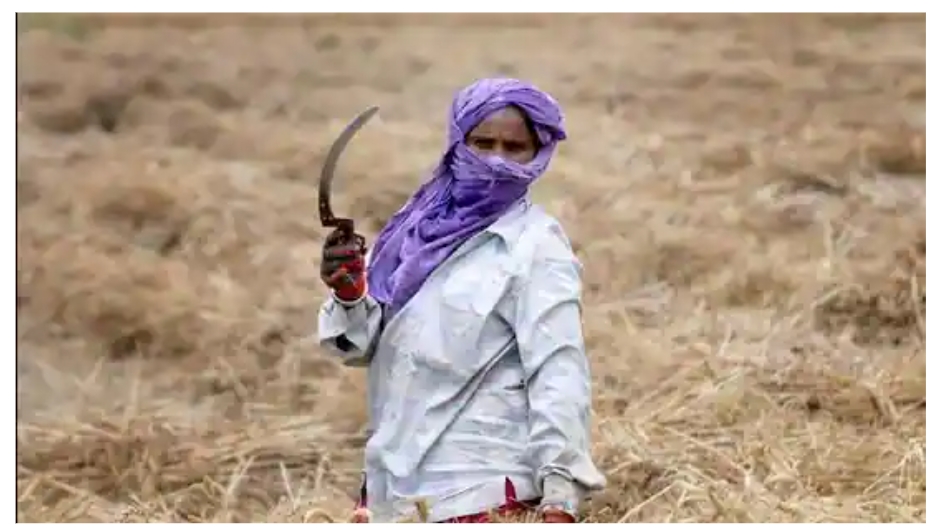The study states about 80% of Maharashtra’s districts are expected to witness a rise in annual mean temperature (AMT) between 2033 and 2050. This will, in turn, affect water security and agro-climatic conditions, leading to diminished yields of sugarcane, pearl millet, wheat, rice and jowar among other crops.
A combination of higher temperatures and increase in rainfall may also threaten agricultural productivity, the study states. (HT FILE)
Rising temperatures and extreme weather events may adversely affect Maharashtra’s agricultural output after the year 2033, resulting in reduced yields of certain rain-fed food crops as well as irrigated cash crops, suggests a recent study published in peer-reviewed scientific journal Springer Nature.
The study — Future Climate Change Scenario over Maharashtra, Western India: Implications of the Regional Climate Model (REMO-2009) for the Understanding of Agricultural Vulnerability — states that about 80% (or 29 out of 36) of Maharashtra’s districts are expected to witness a rise in annual mean temperature (AMT) between 2033 and 2050. This will, in turn, affect water security and agro-climatic conditions, leading to diminished yields of sugarcane, pearl millet, wheat, rice and jowar among other crops.
“The present study indicates that the majority of districts may undergo a rise in temperature between 0.8 and 1.2 degrees Celsius by 2050… The mountain regions (of Western Ghats) in Pune, Satara and Raigad districts exhibit the highest increase (of 1–2.5 degrees Celsius) in AMT followed by Solapur (by 1.2–1.75 degrees Celsius),” said Rahul Todmal, assistant professor of geography at Vidya Pratishthan’s ASC College in Baramati, Pune district, who authored the study.
Todmal’s analysis is based on projected climate data for the period between 2015 and 2100 obtained from the Indian Institute of Tropical Meteorology (IITM) in Pune, as well as projections provided by the International Panel on Climate Change in its Fifth Assessment Report published in 2014.
Using applied statistical techniques, as well as results from past agronomic studies, Todmal arrived at future projections for temperature and rainfall patterns in Maharashtra and correlated them with changing crop patterns in the state.
The study however, is limited by a lack of experimentation to corroborate these projections. Instead, it uses results from past experimental studies undertaken by government and non-government institutes, in Maharashtra as well as other parts of the country. Their applicability for Maharashtra is only in a broad sense, the study clarifies.
Todmal’s findings suggest that along with an increase in AMT, Maharashtra is also likely to witness an increase in annual rainfall by 18% to 22% in the foreseeable future. Vidarbha and Konkan regions, in particular, should expect an assured increase in rainfall by 2050, Todmal pointed out. “This rainfall increase can be destructive and will pave way for extreme events. It may result in repetition of the catastrophic flood events as experienced in Kolhapur, Sangli and Satara in August 2019,” he said.
“Agronomic studies have confirmed that warmer climatic conditions never favour agricultural productivity. The future rise in temperature is very likely to reduce the productivity of traditional rain-fed crops like jowar, bajra and pulses, as well as irrigated cash crops like sugarcane, onion and maize. The rise in annual minimum temperature, particularly during the winter season, may adversely affect wheat productivity,” Todmal added.
Simultaneously, a significant increase in the monsoon rainfall, particularly over Vidarbha and Western Ghats, may also increase the rate of leaching (nitrates) in soil and adversely impact the decomposition of organic matter due to water saturation. A combination of higher temperatures and increase in rainfall may also threaten agricultural productivity by catalysing an increase in fungal diseases and bacterial leaf-blight, the study notes.
Future warming (up to at least 2.5 degrees Celsius) and increased rainfall (leading to more atmospheric and surface moisture) over Maharashtra is “inevitable” and has the potential to “negatively affect the productivity of agricultural food grains as well as cash crops”, the study concluded.
The findings of this study found resonance among independent experts.
“Under the circumstances presented in the study, temperature variations may marginally affect the productivity of principle crops like sugarcane, rice, sorghum and millet. However, it may have some major effect on wheat productivity,” said AN Ganeshamurthy, agriculture expert and emeritus scientist with the Indian Council of Agriculture Research (ICAR) in Bengaluru.
Ganeshmurthy clarified that these losses may also be offset through appropriate interventions, such as furrow bed irrigation systems for crops like cotton and sorghum, which would help them escape the kind of surface flooding that is projected to occur.
Naman Gupta, a former climate change advisor to Maharashtra government who has reviewed the study, said these findings reaffirm the risks of climate change to valuable resources, such as food and water. “It is high time to integrate climate information in existing policies and programmes to ensure than impending risks can be minimised.” Such integration, Gupta said, is imperative not just in the sectors of agriculture and water, but also forestry, public health, infrastructure and disaster management.
Article Credit: hindustantimes
